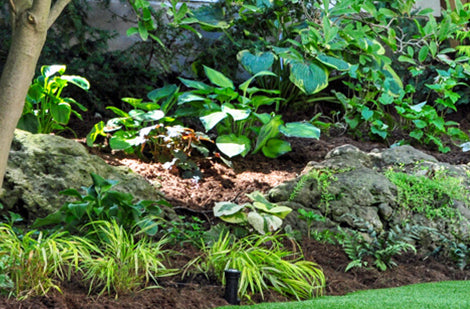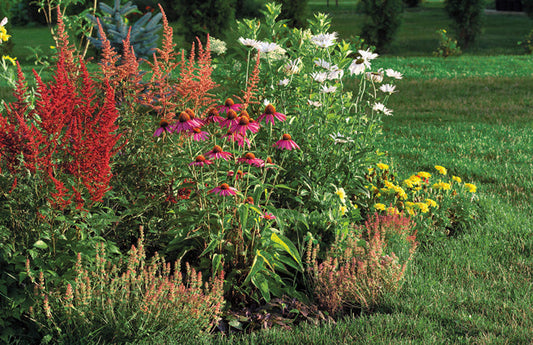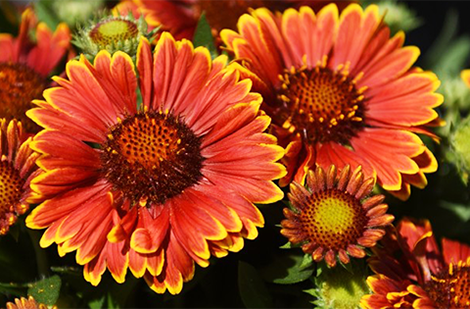Primula x elatior CRESCENDO®
CRESCENDO® Primerose
CRESCENDO® Primerose
Exposure
- Partial shade
Rusticity
Bloom time
- May
- June
- Spectacular flowers
- Abundant flowers
- Attratces butterflies
- Spring blooming
- Unique
Primula x elatior 'Crescendo® Series: A Burst of Vibrant Colors for Your Early Spring Garden
The 'Crescendo® Series' (Primula x elatior 'Crescendo®) is a remarkable flowering perennial that will bring an explosion of vibrant and cheerful colors to your garden from late winter. This hybrid variety is distinguished by its large, cup-shaped flowers, available in a vibrant array of colors, including pink, yellow, red, orange, and purple.
Exceptional Features:
- Early Spring Bloom: The 'Crescendo®' primrose blooms from late winter to early spring, among the first flowers to brave the cold, announcing the arrival of warmer days.
- Large Cup-Shaped Flowers: The large, cup-shaped flowers, measuring 5 to 7.5 cm in diameter (2 to 3 inches), offer a vibrant and colorful spectacle that will illuminate your spring garden.
- Bright and Varied Colors: Available in a wide range of vibrant colors, including pink, yellow, red, orange, and purple, the 'Crescendo®' primrose will bring a touch of cheerfulness and joy to your garden.
- Compact Plant: With a mature height of 20 to 30 cm (8 to 12 inches ) and a spread of 20 to 25 cm (8 to 10 inches), the 'Crescendo®' primrose is a compact plant that is perfect for borders, containers, and miniature gardens.
- Increased Hardiness: The 'Crescendo®' primrose is hardy to zone 4, which means it can withstand winter temperatures down to -34°C.
Growing Information for Optimal Bloom:
- Soil: The 'Crescendo®' primrose prefers rich, well-drained, and slightly acidic soil. It also tolerates neutral soils.
- Light: This perennial thrives in both full sun and partial shade. Avoid direct sunlight during the hottest part of the day, which can fade the flowers.
- Watering: Regular watering is important, especially during dry periods. Allow the soil to dry slightly between waterings.
- Fertilization: Apply a balanced organic fertilizer in spring to promote abundant blooms.
- Division: Dividing the plant every 3 to 5 years helps keep it healthy and encourages continued blooming.
Plant details
Dimensions
Dimensions
Characteristics
Characteristics
Habit:
- Spreading
Flowering colours:
Plant needs
Plant needs
Watering:
- Prefers constantly moist soil. Water as soon as the soil begins to dry out
- making sure not to flood the plant.
Maintenance:
- Low maintenance. Remove spent flowers after flowering.
Soil requirement:
- Well-drained
- moist
- rich
- slightly acidic
Features
Features
Resistance:
- White-tailed deer
Attract:
- Pollinators
Use:
- Clumps
- Flowerbeds
- Rockeries
Attribute:
- Toxic for dogs. cats. horses.










Related articles
-

Perennials for all occasions
Read the articleOsez créer des associations inédites qui sauront refléter votre personnalité, même si pour cela vous deviez déplacer certaines vivaces pour mieux les mettre en valeur.
-

Landscaping with perennials
Read the articleVariétés à découvrir, la tomate se savoure crue, en sandwich, en bruschetta ou en salade. Cuite, c'est l'ingrédient de base de sauces, soupes et salsas.
-

Perennials proper maintenance: cut and fertilize
Read the articleLa grande popularité des vivaces vient du fait qu'après avoir été oubliées pendant des mois au cours de l'hiver, elles réapparaissent sur la scène plus énergiques et surprenantes que par...
-

How to plant perennials in your garden
Read the articleEn pénétrant au jardin, ce sont souvent les plantes vivaces que l’on remarque en premier. Un massif de sauges, d’hémérocalles, d’astilbes, d’échinacées ou de lavande offre un spectacle d’une beauté...


















